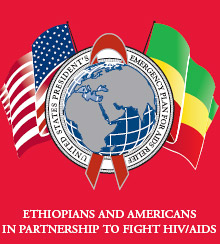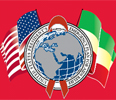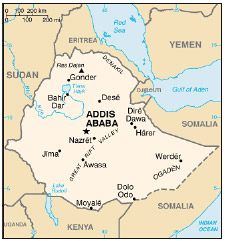| 2008 Country Profile: Ethiopia PDF version PDF version

 |
|
2008 Country Profile: Ethiopia
National HIV prevalence rate among adults (ages 15-49): between 0.9 and 2.1 percent1
Adults and children (ages 0-49) living with HIV at the end of 2007: 980,0001
AIDS deaths (adults and children) in 2007: 67,0001
AIDS orphans at the end of 2007: 650,0001
Ethiopia is one of PEPFAR’s 15 focus countries, which collectively represent approximately 50 percent of HIV infections worldwide. Under PEPFAR, Ethiopia received more than $48 million in Fiscal Year (FY) 2004, more than $83.7 million in FY 2005, approximately $123 million in FY 2006, and $241.8 million in FY 2007 to support comprehensive HIV/AIDS prevention, treatment and care programs. PEPFAR is providing more than $354.5 million in FY 2008. | |
Recognizing the global HIV/AIDS pandemic as one of the greatest health challenges of our time, President George W. Bush announced the President’s Emergency Plan for AIDS Relief (PEPFAR) in 2003 — the largest international health initiative in history by one nation to address a single disease. The United States is changing the paradigm for development, rejecting the flawed “donor-recipient” mentality and replacing it with an ethic of true partnership. These partnerships are having a global impact and transforming the face of our world today.
Partnership to Fight HIV/AIDS
Working in partnership with the people of Ethiopia, the U.S. Government (USG) is strongly committed to the “Three Ones” principles: one national HIV/AIDS action plan, one national monitoring and evaluation system, and one national coordinating authority. The Strategic Framework for the National Response to HIV/AIDS in Ethiopia for 2001–2005 guides HIV/AIDS programming, and an expanded Government of Ethiopia “Road Map” for 2007–2008 is currently under development. To improve program effectiveness under the new strategic plan, the government has moved all of its HIV/AIDS coordinating bodies under the direction of the Ministry of Health.
Key activities under PEPFAR include:
- Leveraging and complementing resources of international partners and Ethiopia’s public and private sectors, including the Global Fund to Fight AIDS, Tuberculosis and Malaria and the Ethiopian Ministry of Health;
- Expanding work with new partners, particularly non-governmental, community-based and faith-based organizations, to maximize coverage and foster sustainability;
- Mobilizing private health care providers for high-quality prevention, treatment and care services;
- Supporting the development of national prevention, treatment and care guidelines and protocols, establishment of structures and systems for effective implementation of the HIV/AIDS program, and human capacity-building through training and site level support;
- Strengthening Ethiopia’s military and police HIV/AIDS response with program services for active duty personnel and their dependents, as well as civilian communities living around rural military health establishments; and
- Fostering supportive environments by encouraging bold leadership, advocating for policy changes, increasing community awareness, and engaging in partnerships with senior government officials and local leaders.
| PEPFAR Results in Ethiopia |
| # of individuals receiving antiretroviral treatment as of March 31,20081 |
|
97,100 |
| # of HIV-positive individuals who received care and support in FY2007 (including TB/HIV)1 |
|
453,200 |
| # of orphans and vulnerable children (OVCs) who were served by an OVC program in FY20071 |
|
273,400 |
| # of pregnant women receiving HIV counseling and testing services for PMTCT since the beginning of PEPFAR1,2 |
|
189,300 |
| # of HIV-positive pregnant women receiving antiretroviral prophylaxis for PMTCT since the beginning of PEPFAR1,3 |
|
6,600 |
| # of counseling and testing encounters (in settings other than PMTCT) in FY20071 |
|
1,709,900 |
| # of individuals reached with community outreach HIV/AIDS prevention programs that promote Abstinence and/or Being Faithful in FY2007 |
|
13,101,400 |
| # of individuals reached with community outreach HIV/AIDS prevention activities that promote Condoms and related prevention services in FY2007 |
|
2,343,800 |
| # of USG condoms shipped from Calendar Year 2004 to 2007 |
|
144,399,000 |
|
Note: Numbers may be adjusted as attribution criteria and reporting systems are refined.
Numbers above 100 are rounded to nearest 100.
1 Total results combine individuals reached through downstream and upstream support.
2 It is possible that some individuals were counseled and tested more than once.
3 It is possible that some pregnant women received antiretroviral prophylaxis more than once over the four-year period, e.g. HIV positive women who were pregnant more than once. |
 |
PEPFAR Achievements in Ethiopia to Date |
|
HIV/AIDS in Ethiopia
Ethiopia faces a mixed epidemic among sub-populations and geographic areas, with an estimated overall HIV prevalence of 2.1 percent among adults ages 15 to 49.1 Based on antenatal clinic surveillance data, HIV prevalence has declined to about 10.1 percent in urban areas and has stabilized to an estimated 1.8 percent in rural areas. The primary mode of HIV transmission in Ethiopia is heterosexual contact. Young women are more vulnerable to infection than young men; urban women are three times as likely to be infected as urban men, although in rural areas the difference between genders is negligible. Populations at higher risk for HIV infection include people in prostitution, police officers and members of the military.
Challenges to PEPFAR Implementation
Ethiopia has a large and extremely vulnerable population of 74.7 million, with an estimated 50 percent of the population living below the poverty line.2 HIV/AIDS remains one of the key challenges for the |
|
 |
| overall development of Ethiopia, as it has led to a seven-year decrease in life expectancy and a greatly reduced workforce.3 Reduced productivity, civil conflict, poor farming conditions, and recurrent droughts leave six to 13 million people at risk of starvation each year.3 In the health sector, there is a shortage of health workers and counselors, in addition to poor access to sparse health services, inadequate sanitation, inefficient procurement systems, and weak monitoring and evaluation systems.3 Conflict, famine and drought have led to widespread population movements, adding to displacements caused by cross-border tensions. As of January 2007, there were an estimated 97,300 refugees in Ethiopia.
Critical PEPFAR Interventions for HIV/AIDS Prevention:
- Conducted on-the-job training and provided mentoring to health care workers in prevention of mother-to-child HIV transmission services.
- Trained youth, teachers, parents and community leaders to provide behavior change communication messages promoting abstinence and faithfulness for youth, and expanded prevention activities in workplaces and private health facilities.
- Provided HIV prevention education, counseling and testing, and support to HIV-affected families along the transport corridor between Addis Ababa and Djibouti.
- Supported efforts by the Ministry of Health and Ethiopian Red Cross Society to strengthen blood transfusion services in the country.
- Engaged with the Ethiopian Orthodox Church, Ethiopian Muslim Development Agency and other faith-based organizations to work with men to address harmful social norms and practices that increase the vulnerability of women and girls to HIV infection.
Critical PEPFAR Interventions for HIV/AIDS Treatment:
- In collaboration with the Global Fund to Fight HIV/AIDS, Tuberculosis and Malaria, supported procurement and distribution of antiretroviral drugs to health facilities across the country providing antiretroviral treatment (ART) services. Supported strengthening of procurement and supply chain management systems for all HIV/AIDS commodities. Provided technical assistance at federal, regional and site levels to ensure immediate and long-term ART program implementation.
- Initiated and supported innovative approaches to meet human resource needs, including twinning initiatives, in-service and pre-service training, task shifting, and new cadres of health workers.
- Enhanced involvement of people living with HIV/AIDS in treatment activities through professional associations and peer education programs.
- Established one national monitoring system for ART and supported sites to build capacity to collect, analyze and use data to improve the quality of ART services.
Critical PEPFAR Interventions for HIV/AIDS Care:
- Provided technical assistance to the Ethiopian Ministry of Health in expanding quality palliative care and TB/HIV services at public and private health facilities.
- Supported efforts of the Ethiopian Ministry of Health to implement a community counselors program through recruitment, curriculum development, training and mentoring.
- Strengthened HIV counseling and testing efforts at public and private facilities, workplace clinics, mobile and service sites.
- Supported efforts of the Ministry of Health to update existing national HIV counseling and testing guidelines.
- Prioritized food and nutrition, safe water, education, protection, and health care in services for orphans and vulnerable children. Established links with Title II Food For Peace and the World Food Program to expand service coverage for these children.
1 UNAIDS, Report on the Global AIDS Epidemic, 2008.
2 CIA, World Factbook-Ethiopia, 2007.
3 World Food Programme, Draft Country Programme Document for Ethiopia (2007-2011), 2006. |
| |  |  |




 PDF version
PDF version